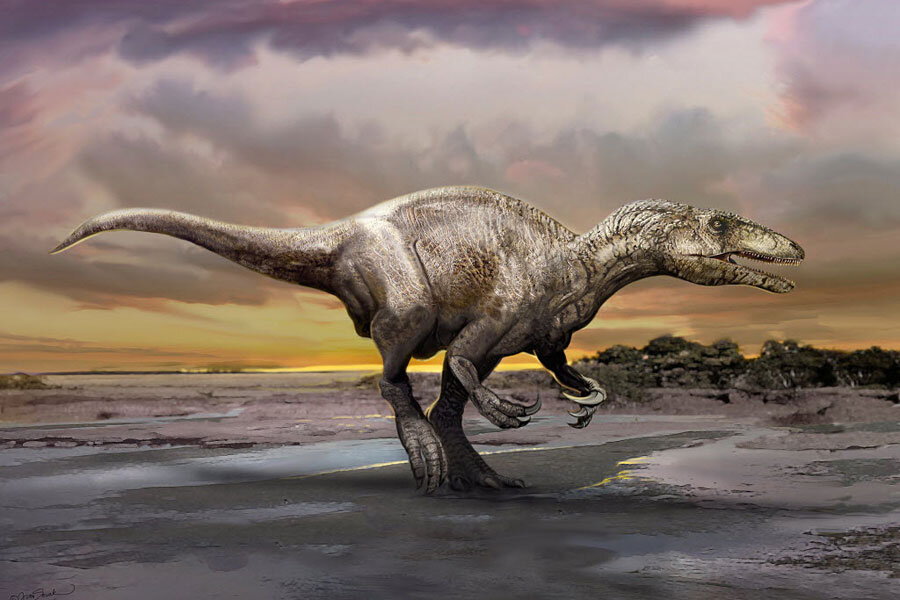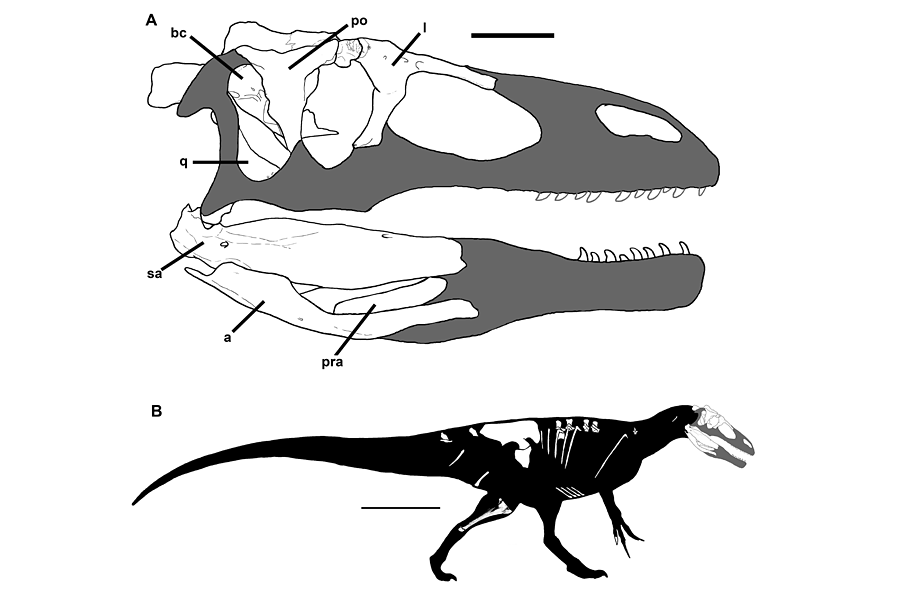Hollow-boned, predatory dinosaur offers insights into enigmatic Megaraptor
Loading...
It's time to update the dinosaur roster, again.
Paleontologists have unearthed an 80-million-year-old dinosaur in Argentina. And this new species, Murusraptor barrosaensis, joins the mysterious clade of the "giant thief," Megaraptor.
This is "the best specimen of this kind of dinosaur ever found," says Philip Currie, a paleontologist at the University of Alberta who co-led the discovery of the new dinosaur, in an interview with The Christian Science Monitor. And this newbie could help researchers learn more about its clawed cousin and where all megaraptoran dinosaurs sit on the prehistoric family tree.
"Ever since they were first discovered, the one definite thing we know about [Megaraptors] is that they aren't easy to fit on the family tree," Thomas Holtz Jr., a paleontologist at the University of Maryland who was not part of the new discovery, tells the Monitor. The large theropods have some features from various distinct families of dinosaurs, making them difficult to place.
Megaraptor namunhuaiquii captured the attention and imagination of all kinds of dinosaur enthusiasts when it was first discovered in the late 1990s, largely because of its vicious-looking claws, Dr. Holtz says. The curved, 13-inch claws are "clearly a killing weapon."
At the time, some people suggested it was a giant version of velociraptor, Holtz says. But subsequent fossils have suggested that it might fit better among allosaurs or tyrannosaurs. Megaraptor "just showed that there was yet another way of being a predator."
Because the new specimen is the most complete megaraptoran fossil yet, according to Dr. Currie, studying its features could help complete the picture of these mysterious animals. The new species is described in a paper published Wednesday in the journal PLOS ONE.
Murusraptor, like Megaraptor, was a large carnivore. The new specimen wasn't fully grown yet but was already over 26 feet long. Currie estimates that it could have grown another 6 feet had it lived to adulthood.
Currie and his colleagues found most of the skull, which could hold key insights into these enigmatic dinosaurs.
The incomplete skull has hints that Murusraptor sported some sort of crest atop its snout. The snout itself is missing from this particular specimen, but the thickness of some of the other bones of the animal's face suggest that it could have supported a display feature.
But it's what's on the inside of the skull that reveals the most tantalizing clues.
The braincase, the part of the skull that houses the brain, is preserved.
"Eventually we'll be able to CT scan these and get a better sense of what the brain is actually like," Holtz says. "There's been previous work on other dinosaurs doing CT scans of the braincase," he says, and by comparing what the ancient beasts' brains looked like, researchers can learn about the relative development of the parts of dinosaurs' brains associated with vision, smelling, sense of balance, and other abilities.
The braincase could also help researchers sort out where the megaraptoran dinosaurs fit on the family tree, Holtz adds. "We do know what the brains of allosaurs and tyrannosaurs looked like, so maybe when we get the CT scans on this thing, we'll be able to see whether it has a brain more like a tyrannosaur or more like an allosaur, or something completely different."
The paleontologists also unearthed a number of teeth belonging to this teenage Murusraptor. But the teeth weren't what Currie expected of the large hunter. "To have such dinky little teeth – they're really about the size of your thumbnail – was a bit of a surprise," he says. The animal was clearly a megapredator, so researchers would have expected it to have rather robust teeth to chomp on prey.
That wasn't the only surprise among Murusraptor's bones.
"We have this long-snouted animal with these giant claws on its hands and feet, and it's a pretty big, massive animal," Currie says. But "the funny thing was that the bones were very light and pneumatic."
Many of the bones along the back of the dinosaur were hollow. In fact, says Currie, the major hip bone, the ilium, is over 3 feet long and filled with gaping holes, and "the sacral ribs were like tubes."
Modern birds have hollow bones too, and the front part of theropod dinosaurs' skeletons is usually pneumatic for balance since they run on their hind-legs. But this case is much more extreme than other ground-bound theropod dinosaurs, and Murusraptor wasn't built to take to the skies.
So why did it have so many light bones?
The simplest explanation, that they helped the enormous animal be fast and agile, Currie thinks is incomplete. This could also be an adaptation for swimming, he says.
Vertebrates tend to flip over in the water, thanks to heavy back bones, and "different animals have dealt with this in different ways," he says. Crocodiles, for example, swallow rocks. The stones sit in the animals' guts as ballast, keeping the crocodiles upright in the water.
Other animals' ribs have thickened up to balance out their heavy backbones too, but this might be an example of the opposite solution: lightening up the bones so as not to be top-heavy in the water.
"I think life was a little hard for this guy," Currie says. "It appears that the animal was bitten at some stage in its life, and one side of the back of the head was heavily infected. The bones likely grew at different rates on the two sides of the head," giving the skull a strange asymmetry.
And it wasn't just the young Murusraptor's head. Ribs along one side of the animal's body had also been broken and healed.
This battered specimen fills in more of the picture of megaraptoran dinosaurs, Holtz says, but it doesn't bring it to full resolution.
"The big question for those of us in carnivorous dinosaur studies isn't solved with this specimen, unfortunately," he says. And that question is where the megaraptorans fit. "But we're only going to be able to solve it with more and more information, so we have to keep on going out there and finding cool new specimens like this one."
Last week another new dinosaur unearthed in Argentina was announced. Gualicho shinyae is also an evolutionary oddball, with features from various different dinosaur lineages. But the paleontologists who discovered Gualicho noted that it had some similar traits to megaraptorans.
Holtz laments that the timing of these publications means that the authors couldn't consider Gualicho in their analysis of Murusraptor. "It will be interesting to see a more complete study that includes all these dinosaurs in it and find out where this group of carnivorous dinosaurs, the megaraptorans, actually fit in the family tree," he says.









